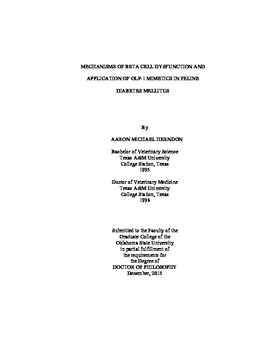| dc.contributor.advisor | McFarlane, Dianne | |
| dc.contributor.author | Herndon, Aaron Michael | |
| dc.date.accessioned | 2017-02-22T22:11:20Z | |
| dc.date.available | 2017-02-22T22:11:20Z | |
| dc.date.issued | 2015-12 | |
| dc.identifier.uri | https://hdl.handle.net/11244/48907 | |
| dc.description.abstract | The causes of beta cell dysfunction and loss in feline diabetes mellitus (FDM) are incompletely understood. Potential causes of beta cell failure include amyloid accumulation, oxidative stress, inflammatory cytokine signaling, and endoplasmic reticulum (ER) stress. GLP-1 and GLP-1 mimetics have been proposed to have a beta cell sparing effect by mitigating cellular stress and pro-apoptotic signaling resulting from these causes, thereby inhibiting cell death. The purpose of the work described herein was three fold: to identify cellular mechanisms associated with beta cell dysfunction in FDM, to develop techniques for the use of freshly isolated feline islets for the study of islet cell dysfunction in cats, and to study the mechanisms and utility of GLP-1 mimetics as a therapy of FDM. Firstly, we tested the hypothesis that the pancreatic islets of cats with FDM have increased inflammation, oxidative stress, and pancreatic amyloid as compared to apparently healthy control cats. The results of this study suggest that oxidative modification and inflammatory cytokine signaling are present in the normal feline islet and increase with obesity and hyperglycemia. Secondly, we developed techniques for the isolation and culture of fresh feline pancreatic islets for in vitro study. Viability of islets was maintained for at least 5 days. An inconsistent response to glucose stimulated insulin production and release was seen in isolated islets, suggesting a lack of normal physiologic responsiveness of the islets. Thirdly, ER stress was induced in freshly isolated islets and the protective effect of the incretin mimetic exenatide was evaluated. Exenatide treatment resulted in a reduction of apoptotic signaling secondary to induced ER stress. Lastly, the clinical utility of incretin mimetics as an adjunct therapy for FDM was tested in a clinical trial evaluating insulin alone versus insulin with adjunct exenatide. Exenatide was not associated with improved glycemic control in cats, but results suggest a potential benefit of weight loss in obese diabetic cats. The study was limited by the small sample size resulting in a statistically underpowered study. Investigations in a larger population of diabetic cats are needed to assess the potential benefits of exenatide in the treatment of FDM. | |
| dc.format | application/pdf | |
| dc.language | en_US | |
| dc.rights | Copyright is held by the author who has granted the Oklahoma State University Library the non-exclusive right to share this material in its institutional repository. Contact Digital Library Services at lib-dls@okstate.edu or 405-744-9161 for the permission policy on the use, reproduction or distribution of this material. | |
| dc.title | Mechanisms of beta cell dysfunction and application of GLP-1 mimetics in feline diabetes mellitus | |
| dc.contributor.committeeMember | Maxwell, Lara | |
| dc.contributor.committeeMember | Breshears, Melanie | |
| dc.contributor.committeeMember | Hanzlicek, Andrew | |
| dc.contributor.committeeMember | Basu, Arpita | |
| osu.filename | Herndon_okstate_0664D_14373.pdf | |
| osu.accesstype | Open Access | |
| dc.type.genre | Dissertation | |
| dc.type.material | Text | |
| thesis.degree.discipline | Veterinary Biomedical Sciences | |
| thesis.degree.grantor | Oklahoma State University | |
